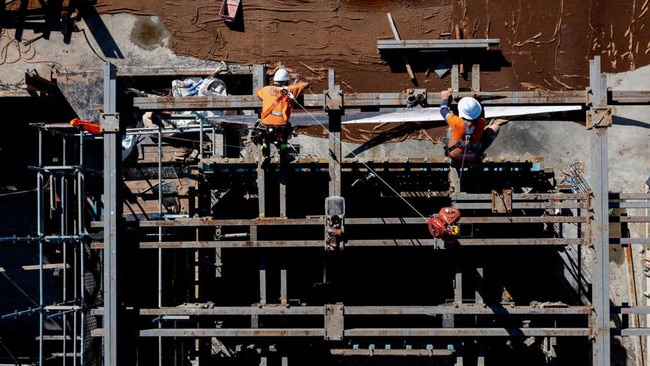Australia is facing one of the biggest collapses ever encountered in the rate of new home building


For good reasons our housing slump will be much greater than that set to be experienced in the US because as well as the inflationary and cost pressures Australian governments and local councils are attacking residential building activity on a massive scale.
The combination will see an unprecedented reduction in residential building capacity in Australia because huge numbers of builders have had enough and plan to leave the industry.
It will take many years – perhaps a decade – to restore capacity.
Some eastern state display home builders tell me that new sales are down by around 75 per cent but they are fearful that there is more to come. For most builders to make a profit on any new home development the price charged must be 15 to 20 per cent greater than it was a few months ago.
At the same time, banks have cut back the amount they will loan on new houses by 10 to 15 per cent and have little understanding off the looming crisis.
Rarely in our history has a key national industry been targeted with such a devastating series of blows.
Along with builders, our banks and governments will also suffer. The housing and land sector has been a river of gold for Federal and State Governments plus local councils who pocket 40 to 45 cent of the cost of a house and land package led by land tax, stamp duty, council rates and taxes, GST and in Victoria the developer contribution tax.
Earlier this week under the heading of Solvency doubts are paralysing the construction sector, I set out how there was a fog of solvency mistrust engulfing both the retail and commercial building sectors.
After publication, people in the industry immediately called telling me that, while the commentary was correct, the problem was much deeper and the consequences to the nation even more severe.
A series of forces are dramatically driving up the cost of new homes and renovations.
The first is approval delay.
Overstaffed state governments, local councils and myriad of bodies are intensifying their efforts to delay or even halt new housing developments. Once a simple low-cost process has now become an industry in its own right.
Councils supported by a vast array of professionals including lawyers, planners and consultants. are referring planning applications to increasing numbers entities. Entities required to be consulted can include those involved in environment, heritage, Indigenous affairs, transport, power/gas, planning, engineering, bushfires, precinct plans and fauna/flora.
These entities have become huge and powerful silos imposing massive cost and time delays on development proposals.

The second set of delays are created by the building process where skills and supplies are in short supply.
When a builder/developer buys land all delays cost money. Not only are the delays getting much longer (the total delay on a new development is often two years) but the higher interest rates and the need to hire consultants to deal with the agencies is ballooning the cost of those delays.
At the same time labour costs are exploding and with inflation on the rise nobody knows just how far labour costs are set to rise.
On the material side, most suppliers are being hit by the labour and other cost increases. Unlike the supermarket area where Coles and Woolworths have the market power to carefully scrutinise the costs of their suppliers before allowing price rises, there is no such market power in the building supply industry.
Some building suppliers are suddenly waking up that they will have very little business in the retail home building area later in 2023 and are looking more closely at their prices.
Similar pressures are been experienced in the apartment market where developers and builders are also faced with approval delays, particularly in NSW. But in the apartment market there is a growing demand for larger up market units.
Normally such a housing slump would create chronic unemployment but the big highly unionised government infrastructure projects in most states are taking up the slack. Bizarrely state governments/local councils having boosted the cost of housing 40 to 50 per cent are now forced to construct social housing to rectify the problem they helped create.

The problems of obtaining profitable housing contracts at prices that are much higher than a few months ago is only part of the industry’s problem.
Almost all builders have a backlog of contracts that were signed at fixed prices that will cost far more to complete than the builders will receive from the buyers.
The name of the game is try and retain solvency. Many builders who signed fixed price contracts but have not started construction or are only 10 per cent completed, are simply telling the owners that it is not possible to build the house at the original agreed price.
Owners weep, but in most instances it is better try and do a deal with the builder and banks to increase the price. Once a house is more than 50 per cent complete the builder has a vested interest in finishing the house albeit at a loss.
However, there is usually a delay between work undertaken and payment. This working capital burden simply can’t be afforded in the current environment so the builders hold back their development until payments are up to date.
Most builders want to want to complete the dwellings but many will quit the industry once they have got through their backlog.
Australia will not have the capacity to build houses at anything like the previous rates and much less bank housing lending will be required.
I don’t get the sense that the banks fully understand what is happening on the coalface and how this will impact their new loans.
In the short term many will be tempted to lower their credit quality to maintain the momentum but APRA will be watching.
The end of the calendar year, when holiday pay is due, is always a tight time for builders but 2022 will be tense. Banks will have to decide which builders to keep alive and which to send to the wall.
The Reserve Bank will not know about the extent of the disaster until it starts to show up in official statistics which could be well into in 2023.
There is grave danger that they will pulverise the industry even further before they understand what’s really happening.





Australia is facing one of the biggest collapses ever encountered in the rate of new home building.